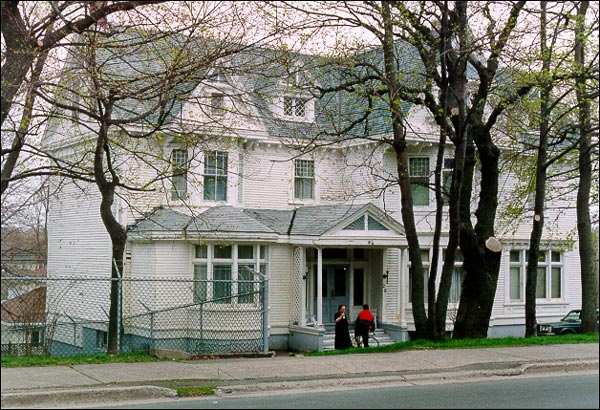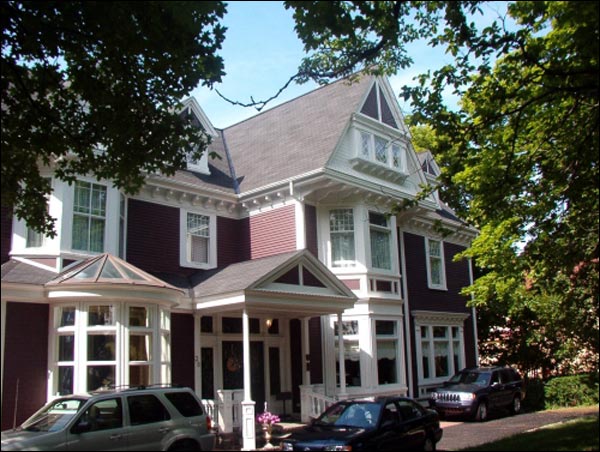Bartra
(28 Circular Road, St. John's)
A private dwelling located in the Rennie's River Valley National Historic District, Bartra has been home to some of the most famous Newfoundlanders and Labradorians of the 20th century.

Located at 28 Circular Road and designed by noted architect William F. Butler, the house was constructed in 1905 to be the private residence of Walter S. Monroe and his family. The rather unusual name comes from Bartra Island, off County Mayo, Ireland, where the family owned property. Monroe was born in Dublin, Ireland, in 1871 and moved to Newfoundland in 1888 to work with his uncle, Moses Monroe. After his uncle's death, Walter Monroe established his own export firm that quickly expanded. He later became president of the Imperial Tobacco Company and was the director of several other firms, including Newfoundland Light and Power.
In 1923 Monroe tried his hand at politics, but was defeated. In 1924 amidst the chaos of trying to find a new leader for Newfoundland, he obtained the support of merchants and the working class to defeat A. E. Hickman in the general election. He served as prime minister of Newfoundland during one of its most turbulent periods, from 1924 until 1928. In 1928 he resigned shortly before the election and retired from politics. Monroe passed away in 1952.
After building Bartra in 1905, the Monroes only spent two years living there. In 1907 Monroe sold the house to William Reid. The Reid family is among the most important in the history of the province, with their most famous achievement being the construction of the Newfoundland Railway. They were also, at one point, the province's largest landowners. They were also involved in pulp and paper, telecommunications and coastal boats. It was said that the Reid Newfoundland Company had the largest payroll on the island, larger even than the government.
The Reids owned Bartra until 1933, when A. E. Hickman purchased it. Another of Newfoundland's most prominent businessmen, Hickman was born in 1875 in Grand Bank. During his life he ran one of the island's most diverse and successful businesses. Operating under the name A. E. Hickman and Company Limited, his company was involved in fish export, marine supplies and the insurance industry. Hickman also capitalized early on the potential of the automobile in Newfoundland and set up one of the first car dealerships on the island.
With all of his business ventures, Hickman managed to find the time to enter politics. He ran for election for the first time in 1913. In 1924 he served as prime minister of Newfoundland for just one month, the shortest term of leadership in the history of Newfoundland.
After his retirement from politics in 1928, Hickman focused on his business enterprises until his death in 1943. The house later passed from the Hickman family to the Andrews family. When owned by Wes and Marion Andrews, it housed the finest and most complete collection of Newfoundland and Labrador prints and engravings. John and Lorraine Cahill bought the dwelling in 1978. The Cahills turned the house into a bed and breakfast called Bartra House.

Bartra has recently undergone a major restoration under the direction of Renee Marquis and Paul Antle who, with the assistance of their contractor Laurence Canning, were extraordinarily attentive to the merits of the house. In 2002 the building was presented with the Southcott Award for Restoration by the Newfoundland Historic Trust.
Located on a sloping lot surrounded by mature trees, this three-storeyed Queen Anne Revival style house overlooks the Rennie's River Valley. The house is of wood construction with a stone foundation and cedar roof shingles. It features leaded glass in several windows and in the main entrance. It also has seven working fireplaces. The exterior of the house has remained unaltered since its construction, something of a rarity for houses built in St. John's dating to the same period.
Bartra was recognised as a Registered Heritage Structure in June 1994.
Also view the Bartra Registered Heritage Structure, and the Bartra - City of St. John's Heritage Site on the Heritage Foundation of Newfoundland and Labrador web site. The Newfoundland and Labrador Heritage Web Site has on its site only a portion of the registered heritage structures in Newfoundland and Labrador. To view a complete list or search for a particular structure visit the Heritage Foundation's Property Search page.




